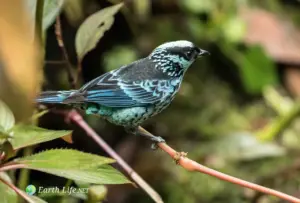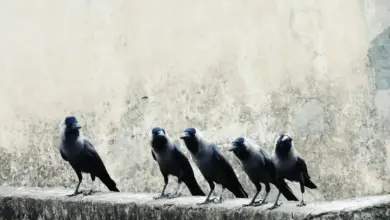Beryl-spangled Tanager
Beryl-spangled Tanager (Tangara nigroviridis)
The Beryl-spangled Tanager, Tangara nigroviridis, is a brightly colored tanager that can be found in the Andean cloud forests.
The Andean subtropical region from Venezuela to Bolivia is home to this small tanager. Unmistakable – entire body is boldly spotted in bright blue-green. This contrasts sharply with the black mask and back. No other tanager is as spangled. Both sexes. Mixed flocks are common between 1,500 and 2,500 meters, in forest as well as at the edges or second growth.
Beryl-spangled Tanagers are found along the eastern slopes the Andes, from Colombia to Bolivia. It is found in Ecuador at an elevation of 700-2,500m (2,300-8200ft), and slightly higher in Peru – 1,500-2900m (4900-9500ft). It is found in second growth and humid montane forests.
The Beautiful Beryl-spangled Tanager
Tanagers are a family of birds that includes the Beryl-spangled Tanager. Around 240 species, mostly brightly-colored fruit-eating bird species, are found in the region.
Tanagers can be small or medium-sized. The white-eared conbill is the smallest species. It measures 4 inches and weighs only 0.2 oz. This makes it smaller than the short-billed Honeycreeper.
The magpie tanager measures 11 inches long and weighs about 2.7 oz. The white-capped Tanager is the heaviest, weighing 4.02 oz. and measuring about 9.4 in.
The size and weight of both sexes is usually similar. Tanagers can be brightly colored or black and white.
Males tend to be more colorful than females or juveniles. The wings of most tanagers are rounded and short.
The bill shape seems to be related to the species foraging habits.
- Common Name
- Beryl-spangled Tanager
Status Beryl-spangled Tanager occurs at altitudes between 1500-2900m in the montane forests on the east slopes of the Andes. It is also found in Ec and BO.
Name in Spanish: Tangara Lentejuelada.

- Kingdom
- Animalia
- Phylum
- Chordata
- Class
- Aves
- Order
- Passeriformes
-
- Families can be found in every ethnicity.
- Emberizidae
- Genus Species
- nigroviridis black and green Tangara (Tupi for brightly colored bird).
Description:
It averages 3.5 – 11 inches (9-28 cm) in length and 0.3-1.4 oz (8.5-40 g) in weight.
)The beryl-spangled tanager is mostly black with iridescent green to blue-green scale-like speckles over much of its plumage.
The face mask, forehead, chin, back, wings, and tail are all black.
Meaning of Name: Tangara: Tupí name, Tangara= dancer, one who turns and skips, originally used for the manakins, but subsequently (Marcgrave 1648) transferred to other bright finch-like birds. nigroviridis: L. niger= black and viridis, virere= green, to be green.
Distribution:
Its range includes Bolivia, Venezuela, Colombia, and Brazil, inhibiting tropical regions
Diet / Feeding:
As per other species in the genus Tangara, the Beryl-spangled Tanager is an omnivore, eating both fruit, nectar and arthropods.
Breeding:
The nest is a mossy cup in a tree fork. The hen lays 2-5 eggs in early March, which she incubates for 13 to 15 days.
The chicks fledge after 14 to 20.
Facts
- Description
- The male beryl spangled tanager has a colorful plumage that is mainly black, with scale-like green or blue-green speckles. Mask, forehead, chin and back are all black.
- Size
- 9 to 28 cm (3 to 11 in.
- Weight
- The weight ranges from 8.5 to 40 grams (0.3 to 1.42 oz.).
- Incubation
- 13 to 15 Days
- Clutch Size
- Two to five eggs
- The Duration of the Feldging Process
- 14 to 20 Days
- Sexual Maturity
- No data
- Life span
- No data
- Range
- This species is found in Bolivia and Colombia. It can also be found in Ecuador, Peru and Venezuela.
- Habitat
- Inhabits tropical regions
- The Population of the United States
- Scientists believe there are at minimum 10,000 mature individuals. The population is stable and not fragmented.
- Status
- IUCN: Low Concern
CITES: Not on the list
USFWS Not listed
Fun Facts
Due to their distinct colors, males and women can easily be distinguished.
Males of most Tanager species are brightly colored.
Ecology and Conservation
They are important seed dispersers that help to promote the growth of new forest. These birds are food for larger predators.
In the absence of any evidence of declines or significant threats, it is assumed that the population is stable.
Tanager Information … Tanager Species … Tanager Species Photo Gallery
References
- ^ BirdLife International (2016). “Tangara nigroviridis“. IUCN Red List of Threatened Species. 2016: e.T22722930A94794064. doi:10.2305/IUCN.UK.2016-3.RLTS.T22722930A94794064.en. Retrieved 12 November 2021.
- ^ a b c d Schulenberg, Thomas S.; Stotz, Douglas F.; Lane, Daniel F.; O’Neill, John P.; Parker III, Theodore A. (2007). Birds of Peru. Princeton NJ, US: Princeton University Press. p. 564. ISBN 978-0-691-13023-1.
- ^ a b Athanas, Nick; Greenfield, Paul J. (2016). Birds of Western Ecuador: A Photographic Guide. Princeton NJ, US: Princeton University Press. p. 378. ISBN 978-0-691-15780-1.
- Robert Ridgely & Guy Tudor, Birds of South America Vol. 1 (Univ. Texas Press, 1989).





